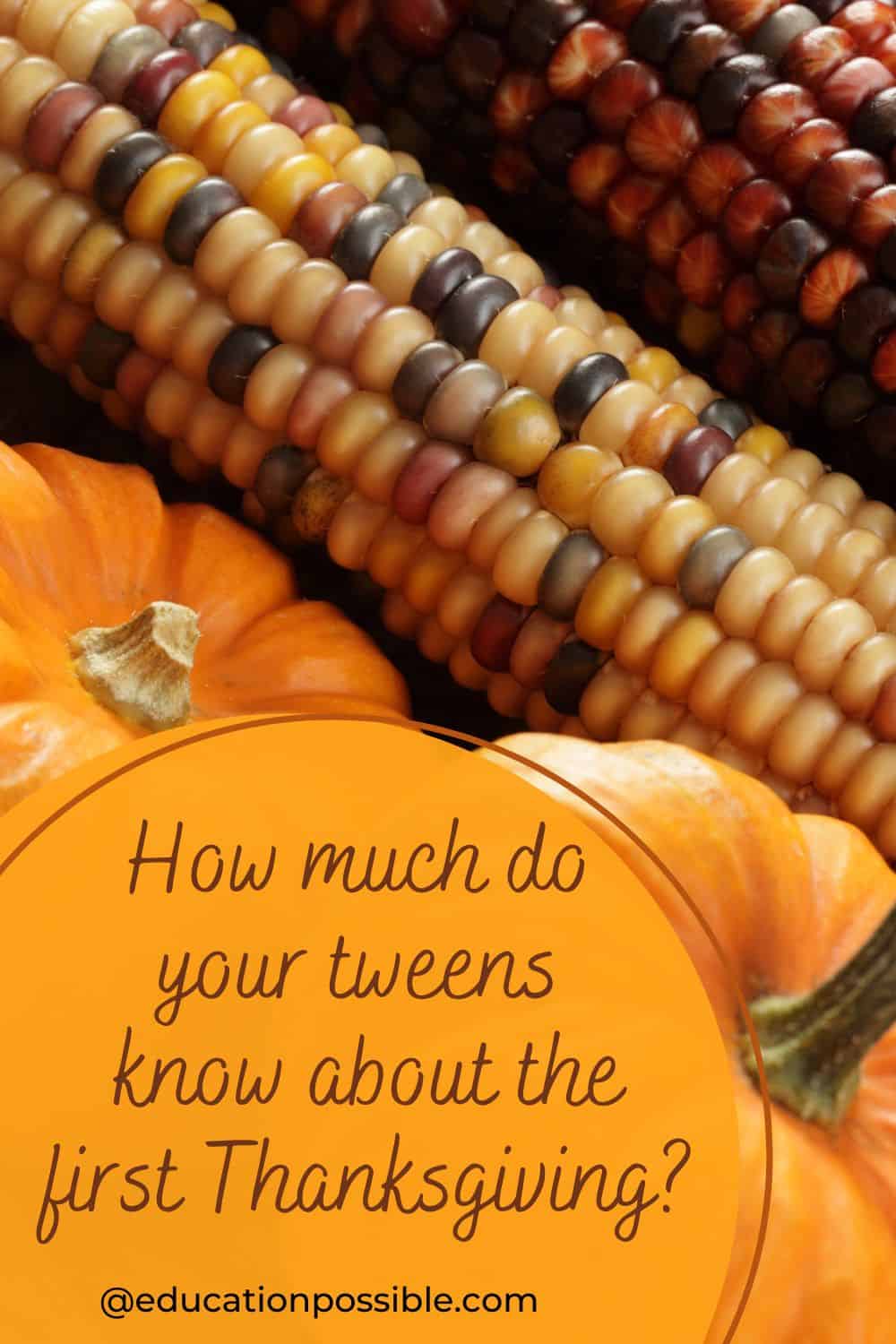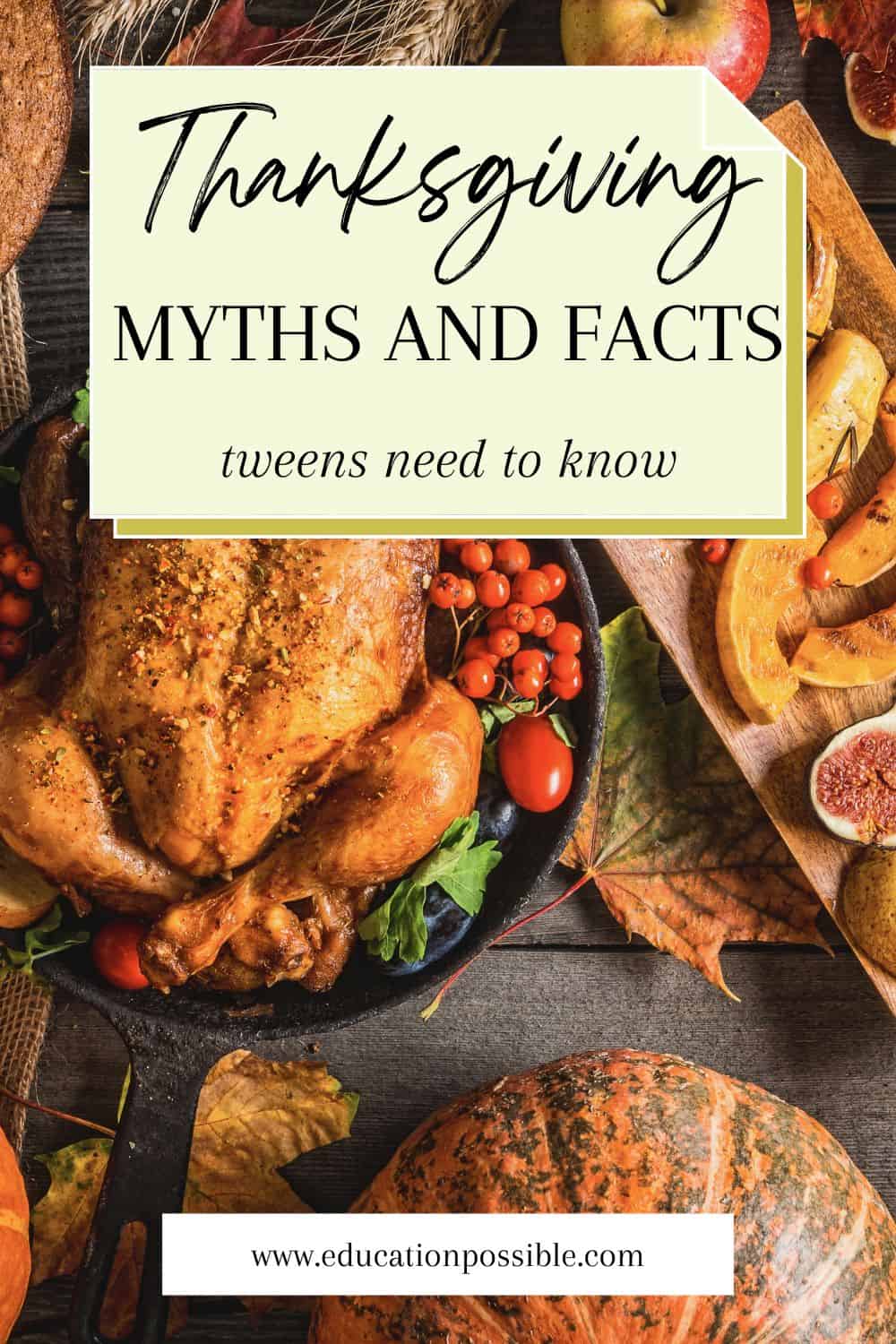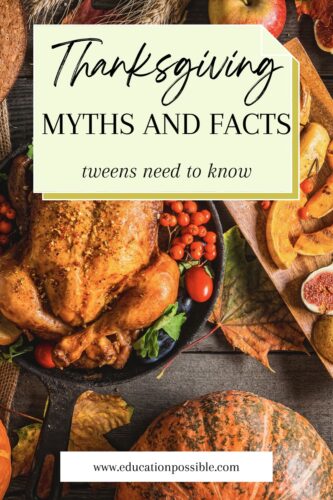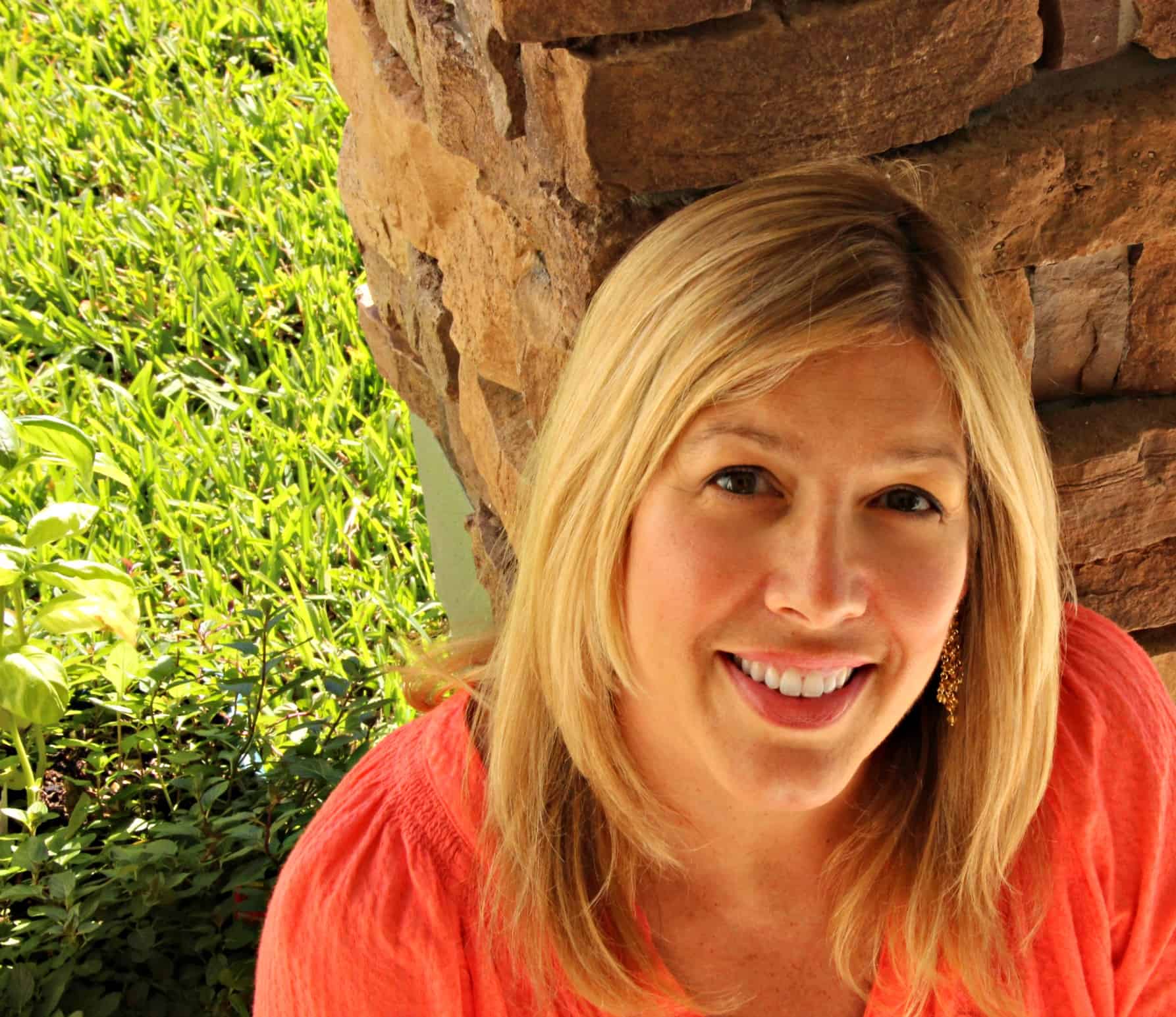Thanksgiving Myths and Facts Tweens Need to Know
It’s time to teach our kids about the Thanksgiving myths and facts as part of our American history studies.
The First Thanksgiving. We all know the story, right? We heard it when we were kids, teachers taught all about it in school. But was what we learned actually true? Unfortunately, there are lots of stories surrounding this event that just aren’t based on facts.
As we look forward to the holiday, it’s time to make sure your tweens understand the story of this part of American history.
Here are some well-known myths and the facts to ponder.

Any links in this post may be affiliate links. See my disclosure statement.
Myths About Thanksgiving
Years ago, I learned that in 1621, months after a brutal winter, the Pilgrims achieved a bountiful harvest and they invited their friends, the Wampanoag Indians, over to share in a splendid meal of thanksgiving.
Kids dressed up as Pilgrims and Indians for plays and recreated the Thanksgiving feast in the classroom. We made Pilgrim hats, Indian headdresses, cornucopia, and Mayflower ships, all out of construction paper.
In our homes, we ate turkey, potatoes, stuffing, and pumpkin pie, all while giving thanks, so we could take part in the tradition that was passed down from that well-known shared meal.
But was it all true?
Not really. Most of it was based on myths.
As part of our early American History studies, I encouraged my girls to do their own research into various events, including this one. Before you sit down at your own Thanksgiving table, let your tweens dig deeper into the history of this national holiday.
It’s crucial that we take the time to learn the facts about this holiday, the settlers, and the Native Americans.
When Was the Real First Thanksgiving?
Today, we celebrate Thanksgiving on the fourth Thursday of November, and often say that it all began in the fall of 1621 with a meal between the Pilgrims of Plymouth Colony and the Wampanoag Indians.
However, this was not the first Thanksgiving feast on these shores. A handful of states, including Florida, Texas, Maine, and Virginia, claim to be the location of the first one.
In fact, indigenous people and Spaniards held harvest festivals at different times throughout the fall months, years before the one we recognize with the Pilgrims.
Thanksgiving Fact or Fiction
Here are four other things about that occasion that are often misconstrued.
Thanksgiving Myth #1
The first Thanksgiving was all about giving thanks.
Thanksgiving History Truth
The event we recognize as the first Thanksgiving wasn’t actually called thanksgiving by the colonists. They considered it a harvest celebration because they were observing their first successful harvest.
When they observed specific days of thanksgiving, they were often somber, religious occasions, separate from harvest festivals. They fasted and said prayers.
While the Pilgrims most likely gave prayers of thanks during the feast, that was not the main reason for the gathering.
The members of the Wampanoag tribe were also quite familiar with the idea of thanksgiving ceremonies as they held them throughout the year to honor various seasons and events.
Encourage your tweens to dig deeper into the differences between a day of thanksgiving and a harvest celebration back in 1621.
Thanksgiving Myth #2
William Bradford invited Chief Massasoit and his tribe over to eat with the settlers.
How the English and Native Americans Came Together
While we know that Chief Massasoit and 90 of his men attended the multi-day harvest festival, it’s not 100% known whether he was invited or came on his own.
Some scholars believe that as part of the celebration, the Pilgrims were shooting guns and cannons into the air, which put the Wampanoags on alert. They then traveled to Plymouth to see what was going on.
The English told them they were celebrating their first harvest, but the tribe didn’t fully trust them, so they stayed to see if they were telling the truth.
Yes, they ate together during this time, but it wasn’t a large single meal, with everyone sitting around a table like good friends. It was more like a polite truce.
As you study this event, let your tween read more about how the two groups came to be together and what they did over the days.
Thanksgiving Myth #3
Our Thanksgiving tables reflect the one between the Pilgrims and Wampanoag.
Truth About the Food
While we may think our traditional menu reflects that first feast, that’s just not the case. In fact, many of the foods we eat weren’t actually served.
Let’s look at the centerpiece of most tables, the turkey. While the limited documentation from that time does mention “fowls” being prepared, it doesn’t specify turkey. Most likely, they would have eaten duck or goose, along with venison and plenty of seafood.
Those potatoes that we love so much? They were not growing in Plymouth in 1621, nor were they a part of the English or Wampanoag diet.
Pumpkin pie? Nope. The first record we find of pumpkin pie comes years later. Plus, as a struggling community, there would have been little to no sugar or butter (not to mention flour) to make such desserts. Pumpkin was probably served, but they likely made it into a type of custard.
See what else your tweens can discover about the dining table from that famous celebration.
Thanksgiving Myth #4
Every year as we celebrate Thanksgiving, we’re carrying on a tradition that has been happening since 1621.
Truth About Our Thanksgiving Holiday
This celebration was not an annual event for the colonists and Native Americans.
We actually didn’t come together as a nation to celebrate Thanksgiving until George Washington proclaimed a national Thanksgiving in 1777. Not every president felt so strongly about observing the event, so this ended in the early 1800s.
While states and territories continued with their own traditions, the country was not celebrating Thanksgiving as a nation.
However, with a weary and divided country, Abraham Lincoln, as a way to bring families together during the Civil war, invoked an image of the Pilgrims and Wampanoag tribe putting aside their differences and sitting around a table to eat.
He made a proclamation that the last Thursday of November should be set aside for a national holiday.
It’s now celebrated on the fourth Thursday of November each year.
See if your tweens can find out how the various states and territories celebrated Thanksgiving before it became a national holiday.
Questions About Thanksgiving
As you teach your older kids about the holiday and this part of our history, have them go deeper by researching and pondering these questions.
- What cultures and tribes had thanksgiving celebrations before the colonists arrived?
- What are some of the harvest traditions of various Native nations?
- What is the cultural meaning behind giving thanks daily?
- What was most likely served in 1621?
- Who was Sarah Josepha Hale and what was her connection to Thanksgiving?
- What was Franklin Roosevelt’s role in the Thanksgiving holiday?
- Why do Canada and America celebrate Thanksgiving on different days?
- What other countries celebrate a national Thanksgiving?
- What do you think the Thanksgiving holiday means to Native Americans?
You can take the learning a step further by having your older students turn their research into a paper or a presentation.

More Thanksgiving Resources
Here are some tools you can use as part of your early American history lessons.
- 1621: A New Look at Thanksgiving
- Giving Thanks: A Native American Good Morning Message
- History Smashers: The Mayflower
1621: A New Look at Thanksgiving History Smashers: The Mayflower
History Smashers: The Mayflower Giving Thanks: A Native American Good Morning Message
Giving Thanks: A Native American Good Morning Message
Additional Learning Ideas
- As you study the first Thanksgiving, make some corn recipes with your older kids.
- Use this Colonial America notebooking unit as part of your history lessons.





Great post! Learning accurate history is important! Thanks for linking up at the Thoughtful Spot Weekly Blog Hop! We hope you stop by again next week!